Eggplant parmigiana, or melanzane alla parmigiana, is a gorgeous Italian casserole dish adored for its rich flavors and comforting texture.
This layered masterpiece features baked or fried eggplant slices alternating with tomato sauce, basil, mozzarella, and Parmesan cheese.
The dish is then baked until golden and bubbly, resulting in a heavenly vegetarian main course or side dish that’s comforting, flavorful, and satisfying.
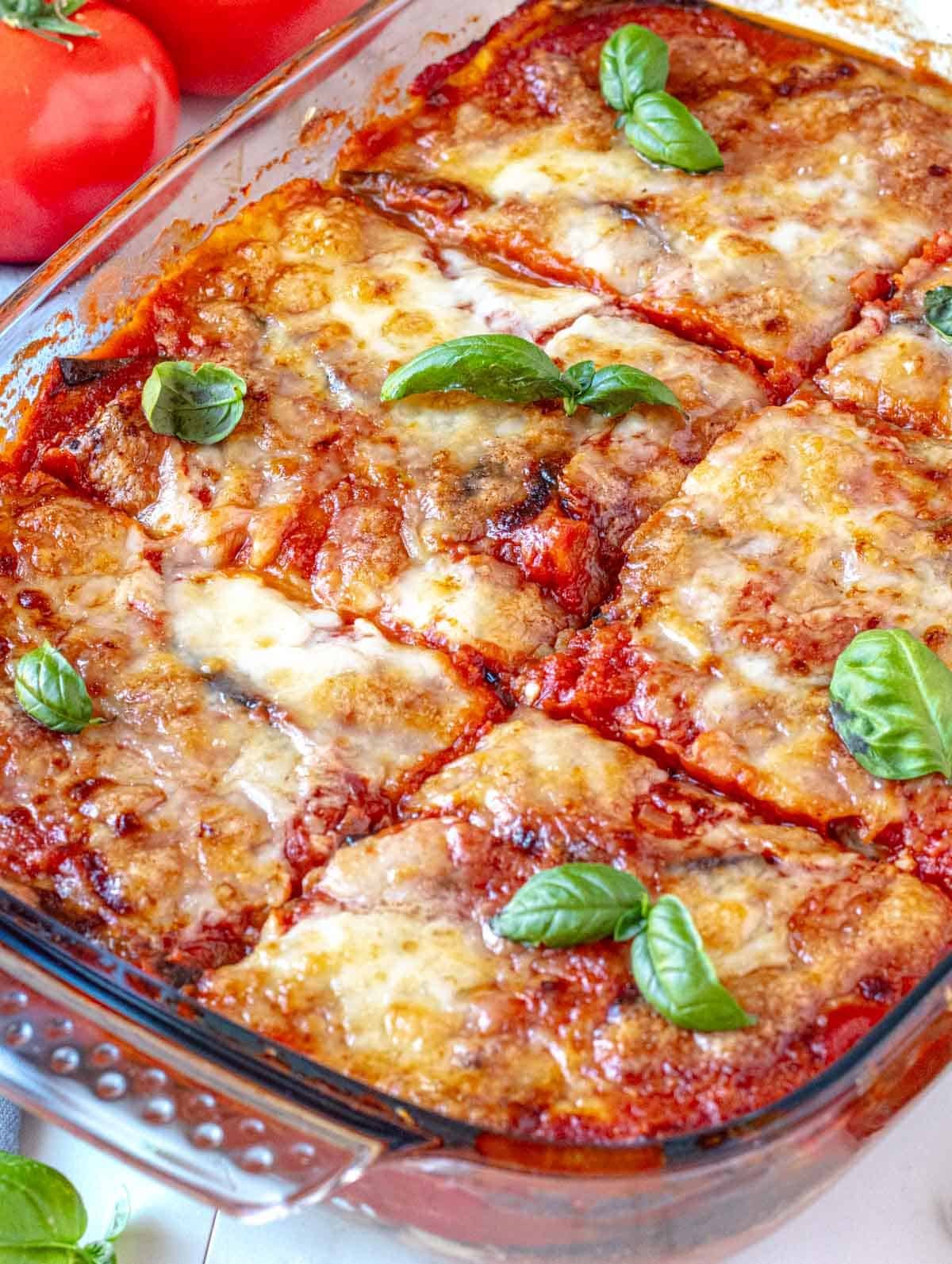
Table of Contents
Don’t have time to read the full blog post? JUMP TO RECIPE HERE!
What is eggplant parmigiana?
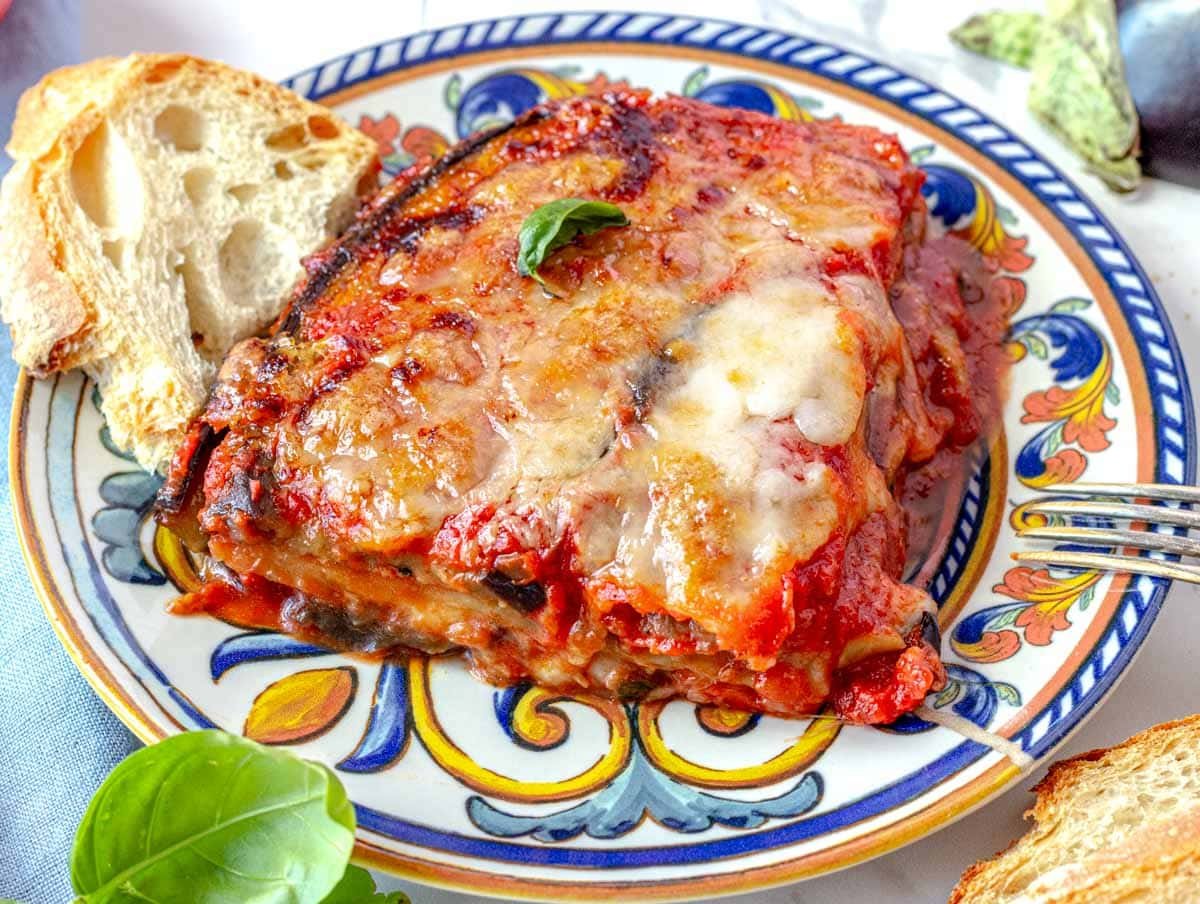
Eggplant parmigiana embodies the essence of Italian home cooking.
Simple Italian ingredients come together to create a triumph of flavors and textures in the safety and comfort of your home kitchen.
Like a vegetarian lasagna or Greek Moussaka, parmigiana is a layered casserole dish.
Thin eggplant slices are hugged by a flavorful tomato sauce, melty mozzarella, and tasty parmesan cheese.
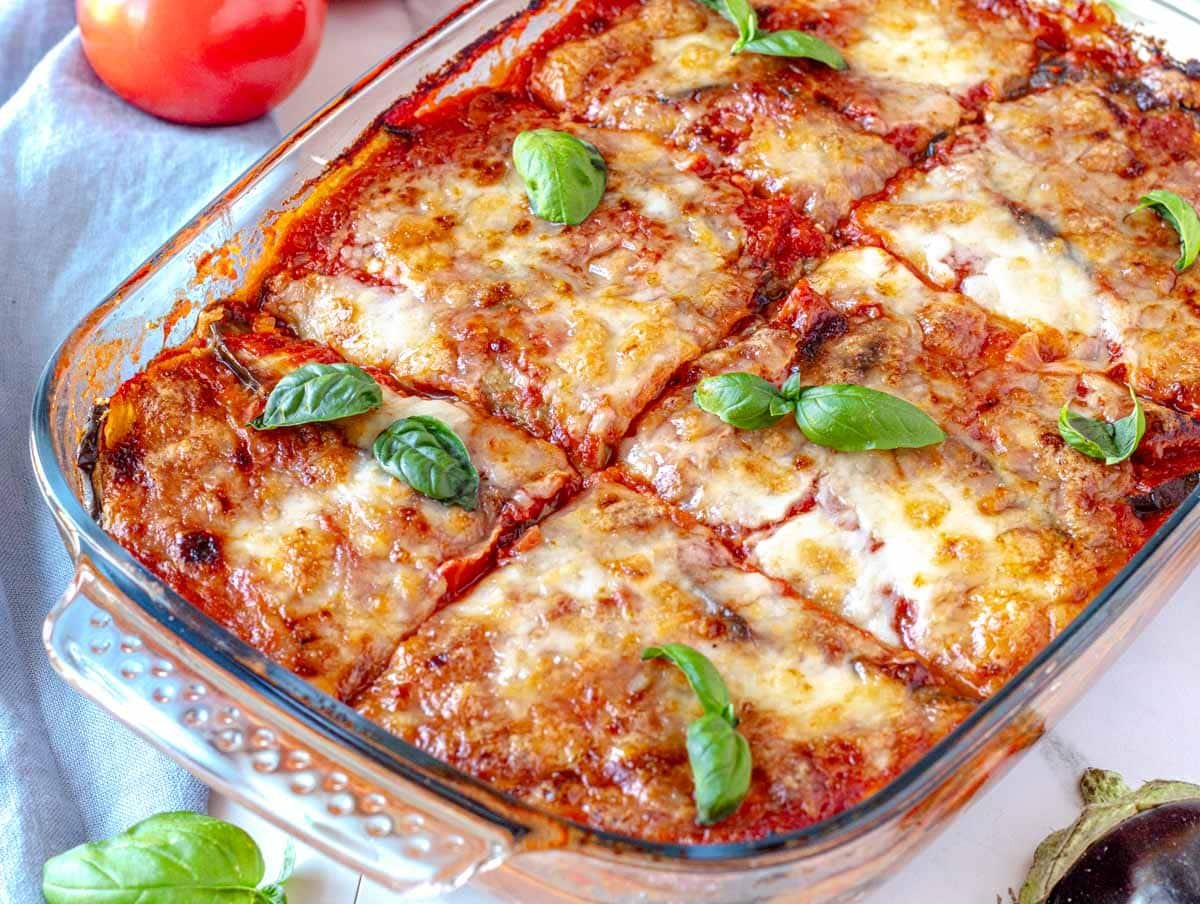
Here, we’ll show you how to make an authentic Italian parmigiana di melanzane with oven-baked eggplant slices rather than deep-fried ones.
Please note that unlike Eggplant Parm – its American cousin – the eggplant slices in Italian parmigiana are not breaded in all-purpose flour, eggs, and breadcrumbs.
Like eggplant risotto, spaghetti al pomodoro, cherry tomato pasta, and rigatoni arrabbiata, parmigiana is one of our favorite dishes when we want something comforting and oozing with a tasty tomato sauce.
Ingredients for eggplant parmigiana
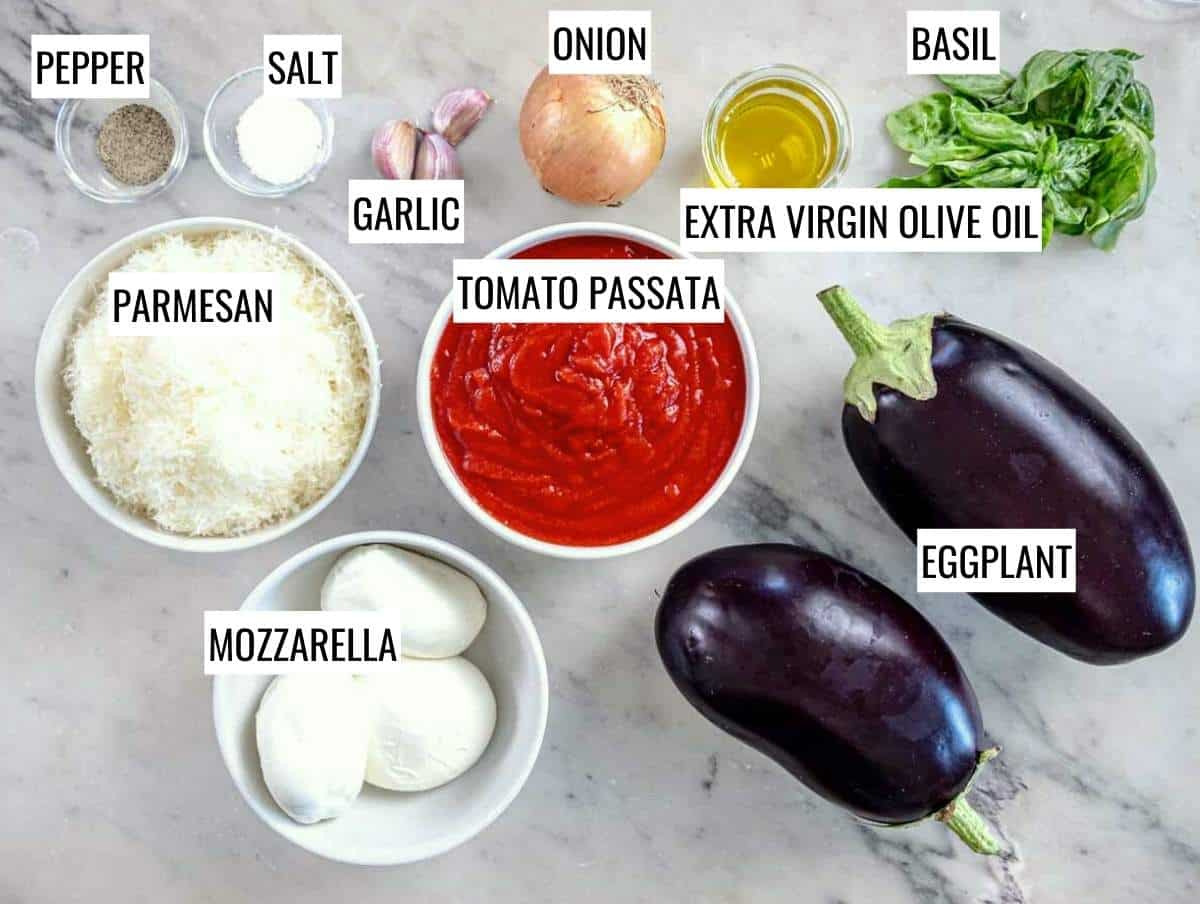
Quantities are in the recipe box at the bottom of the page.
Eggplants
Italian eggplant and globe American eggplant are the best varieties to make Italian parmigiana.
They are the most common eggplant variety, oval-shaped with dark, shiny skin.
There is no need to peel the eggplants or salt and purge the eggplant slices to remove bitterness, as most modern eggplants are grown without bitterness.
Tomato Puree
We recommend tomato puree (US and Canada) or tomato passata (Europe and Australia).
Try to get one in a glass bottle imported from Italy; they are less acidic and slightly sweeter, and you won’t need to add sugar to the sauce.
If you use an imported Italian brand, it will probably say “Passata” on the bottle, sometimes localized by the word “Puree” if you are in the USA and Canada.
You can use smooth passata or chunky passata; that’s up to you.
Substitute passata for canned crushed tomatoes, although they tend to be more watery, so you might have to cook the sauce a little longer.
You can use store-bought marinara sauce for a speedier parmigiana.
Garlic and Onion
Garlic and onion add flavor and aroma to the tomato sauce.
We want something similar to a marinara sauce but slightly sweeter, so we add the onion.
Try to use fresh ingredients, not onion powder or garlic powder.
Olive oil
We use good-quality extra virgin olive oil to gently fry the onion and garlic, which creates a flavor base for the “sugo” (sauce) of this parmigiana di melanzane.
We also brush the eggplant slices with extra-virgin olive oil before baking them. This method cooks them faster and has more flavor.
Parmigiano Reggiano
I’d avoid generic “parmesan” and opt for imported Parmigiano Reggiano or Grana Padano. Also, getting a piece and grating it at home is best to ensure you get the real deal.
Often, pre-grated storebought parmesan includes cheaper ingredients and stabilizers that melt terribly.
You can substitute Pecorino Romano or Pecorino Sardo for Parmigiano Reggiano, but remember that they have a pungent, almost spicy taste, and some people might not like them.
Vegetarians & Vegans: Just so you know, while we consider all cheeses vegetarian, technically, neither Parmigiano Reggiano nor Grana Padano are vegetarian because they are made with animal rennet.
If that’s a problem, please replace them with a vegetarian or vegan cheese alternative.
Mozzarella
We use fresh fior di latte mozzarella, which comes stored in water.
Vacum-packed and grated mozzarella, generally used for pizza, is also ok.
Vegetarians & Vegans: Mozzarella is suitable for a vegetarian diet. For vegans, grated melty vegan cheese is easily found in most supermarkets. We tested Vio Life and Simply V, and they both worked well.
Basil
Parmigiana should have a mild basil aroma, so fresh basil leaves are non-negotiable (at least for us).
If you don’t have access to fresh basil, substitute dried oregano, although we recommend sticking to fresh basil if you can.
Salt and Pepper
We add sea salt or kosher salt for taste and freshly ground black pepper for aroma. Parmigiana is not spicy.
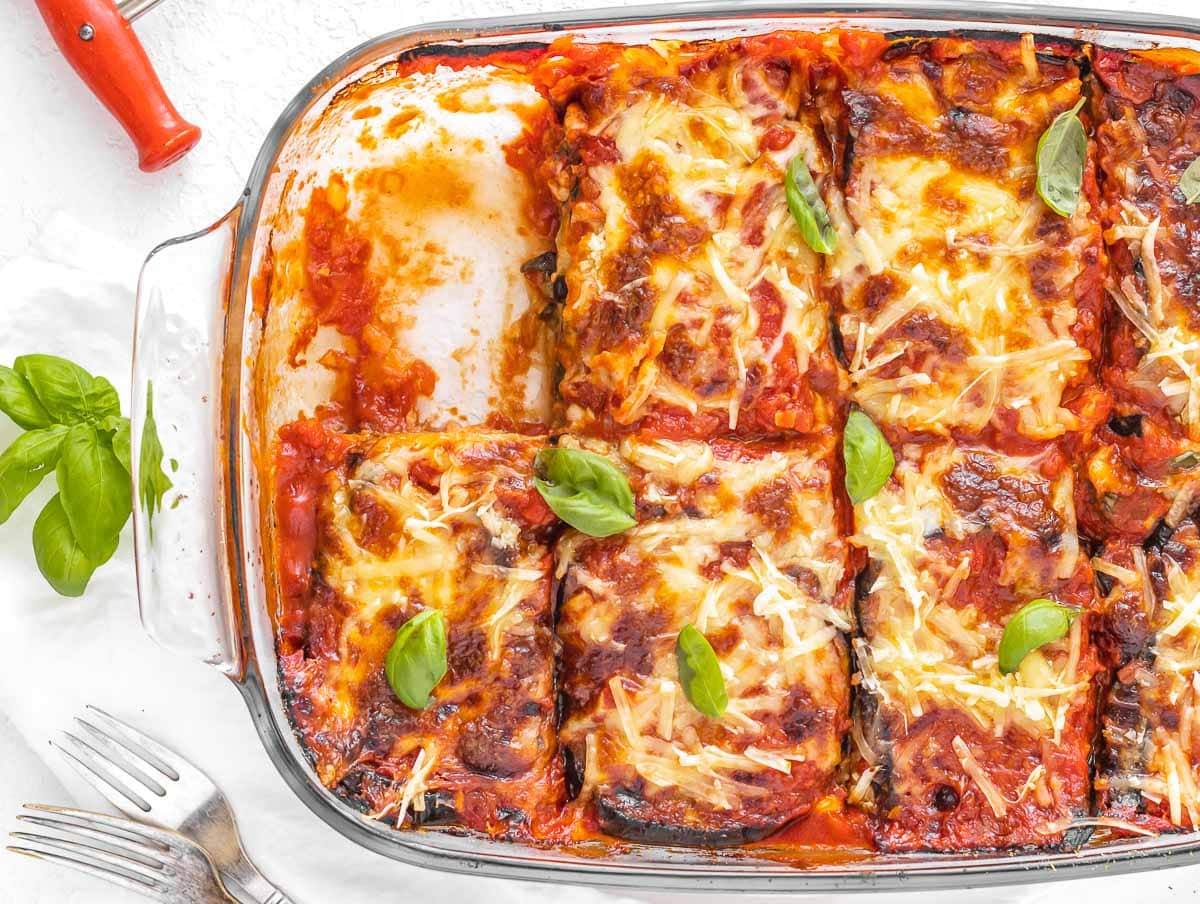
How to make eggplant parmigiana + Nico’s Tips
US cups + grams measurements in the recipe box at the bottom of the page.
1. Make the Tomato Sauce
Heat the olive oil in a large pan with low edges.
Add the finely chopped onion and sauté for 3 minutes, then add the grated or pressed garlic and sauté for one more minute.
Pour in the tomato passata, season with salt and black pepper, and simmer on medium to low heat for 30 minutes, stirring occasionally.
In the meantime, bake the eggplants.
Tip: The sauce should be dense and not watery once cooked.
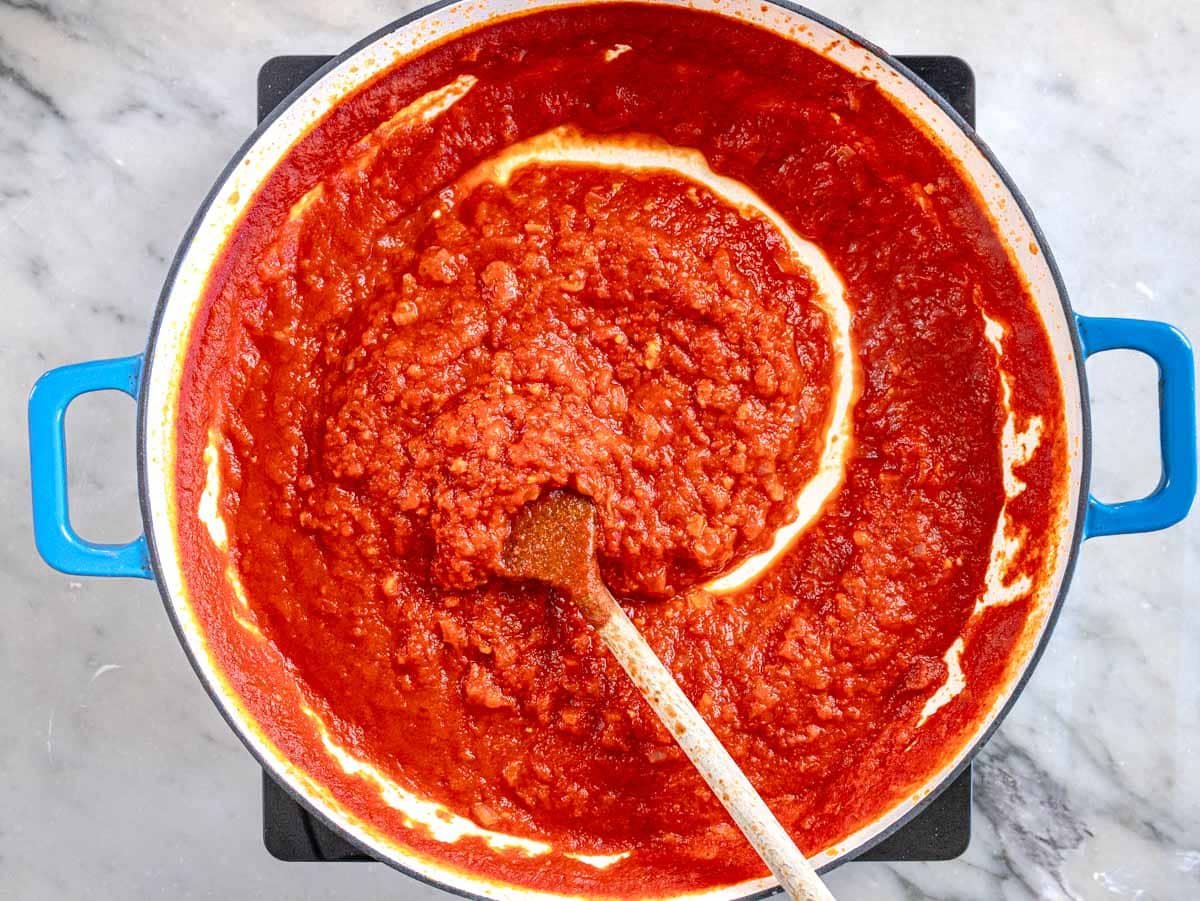
2. Bake the Eggplants
Preheat the oven to 430°F or 220°C. Line three large baking trays or baking racks with parchment paper.
Rinse and dry the eggplants, then cut off their stems.
Cut the eggplants into 1/4-inch (0.6 cm) slices.
Arrange the eggplant slices on the baking trays on a single layer without overlapping.
Brush with olive oil and sprinkle with a pinch or two of salt.
Bake in the oven (fan-assisted if your oven has that) at 430°F or 220°C for about 25 minutes until the eggplant slices are golden-brown.
Tip: You can bake the three trays simultaneously but might have to swap their position as they cook, depending on your oven.
Using the fan-assisted function of the oven helps distribute the heat when the oven is crowded with three baking trays.
All slices should be golden brown on top. This method makes the eggplant tastier and less watery, making a creamier and more flavorful parmigiana.
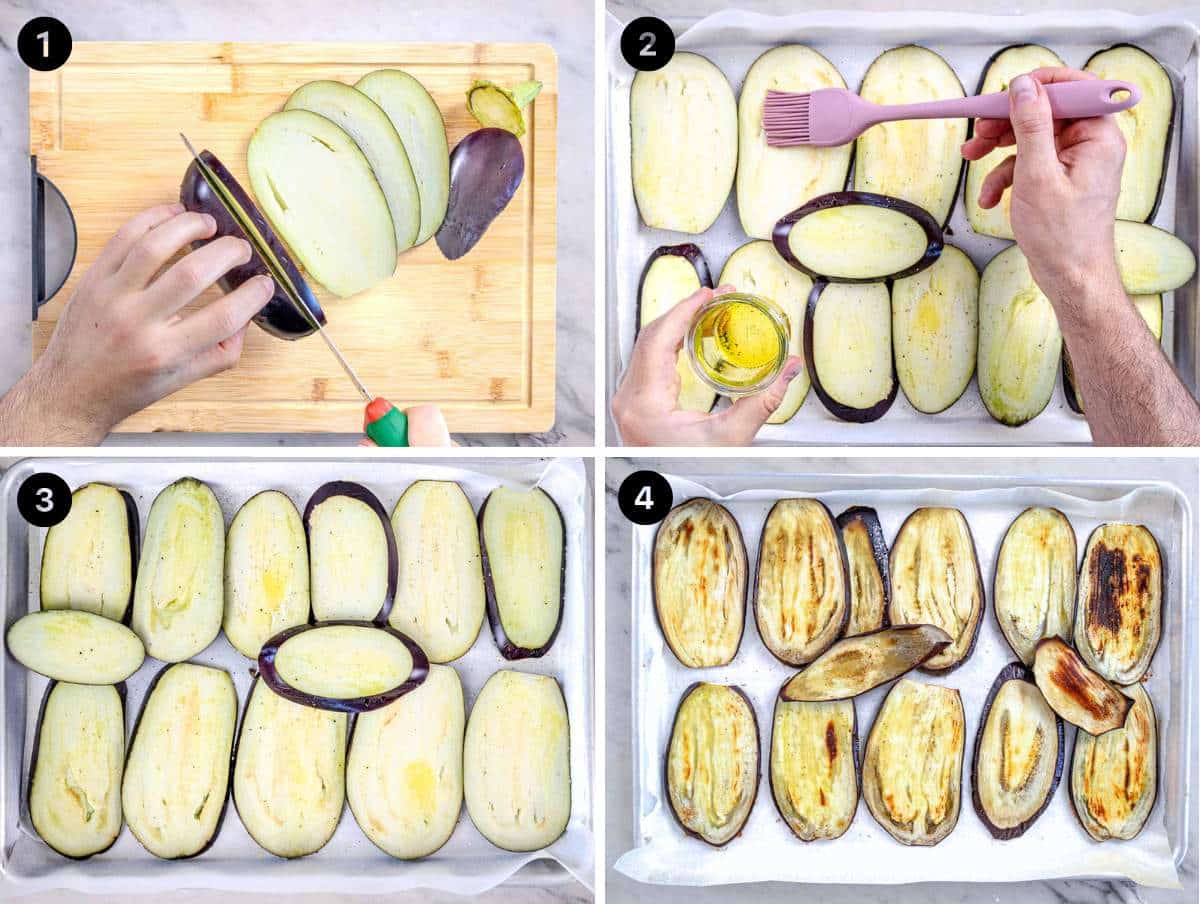
3. Assemble the Parmigiana
BEFORE YOU START: We make parmigiana with four layers of eggplant slices, and the last layer has more sauce, parmesan, and mozzarella than the other layers.
Keep this in mind when you add the sauce and the cheese.
Add a little tomato sauce to a large baking dish or casserole (9 x 13 inches | 23 x 33 cm). We use a Pyrex dish.
Add the first layer of eggplant slices. Arrange them tight but without overlapping. Cut the slices with scissors if they are too large.
Cover with a ladleful of tomato sauce and spread it with the back of a spoon.
Drizzle with a couple of handfuls of finely grated parmesan cheese, a sprinkle of grated or chopped mozzarella cheese, and a handful of basil leaves.
Optionally, you can add a drizzle of extra virgin olive oil.
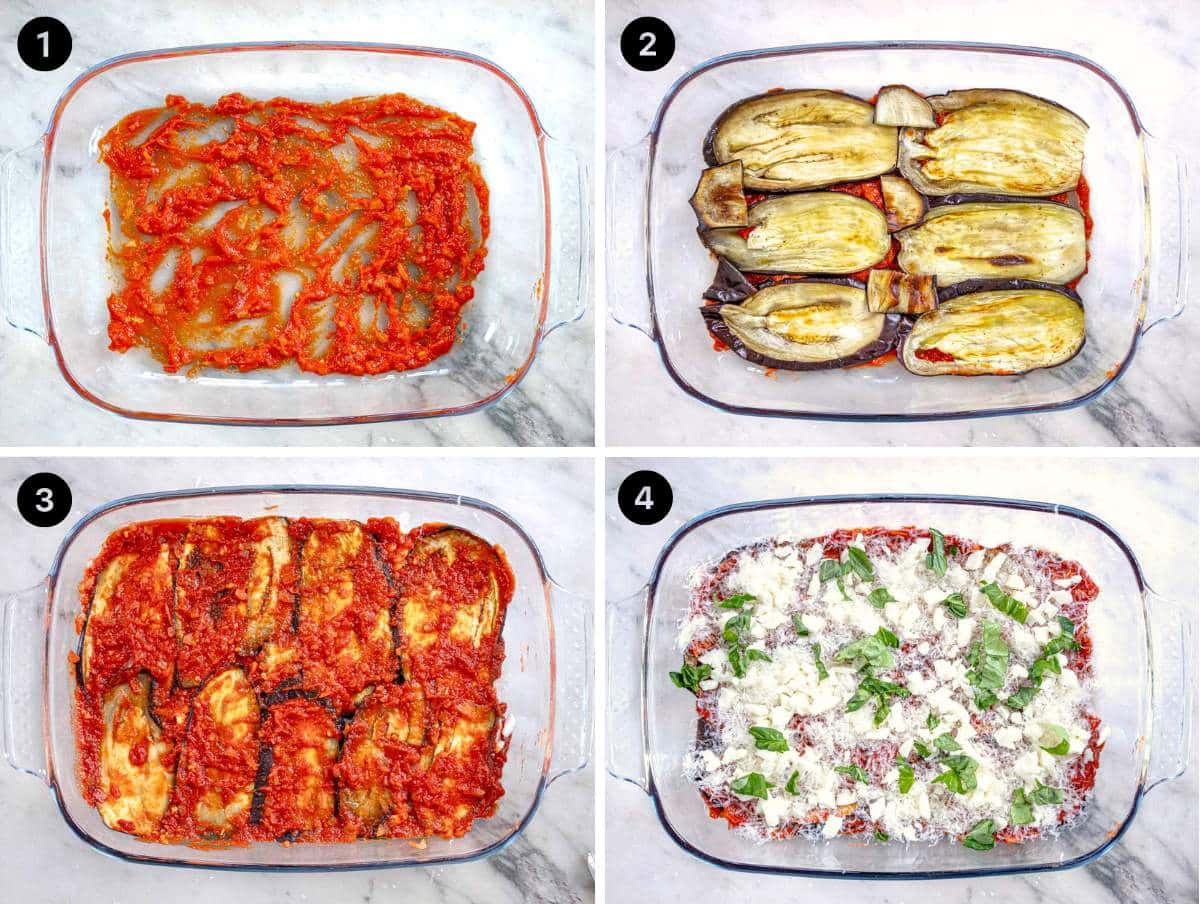
Cover with the second layer of eggplant slices, this time arranged in the opposite direction.
Add a ladleful of tomato sauce, a handful of grated parmesan, one of mozzarella, and some fresh basil leaves.
Repeat with two more layers of eggplant (4 eggplant layers total).
The last layer should have more tomato sauce, parmesan, and mozzarella than the other layers. Don’t add basil on top.
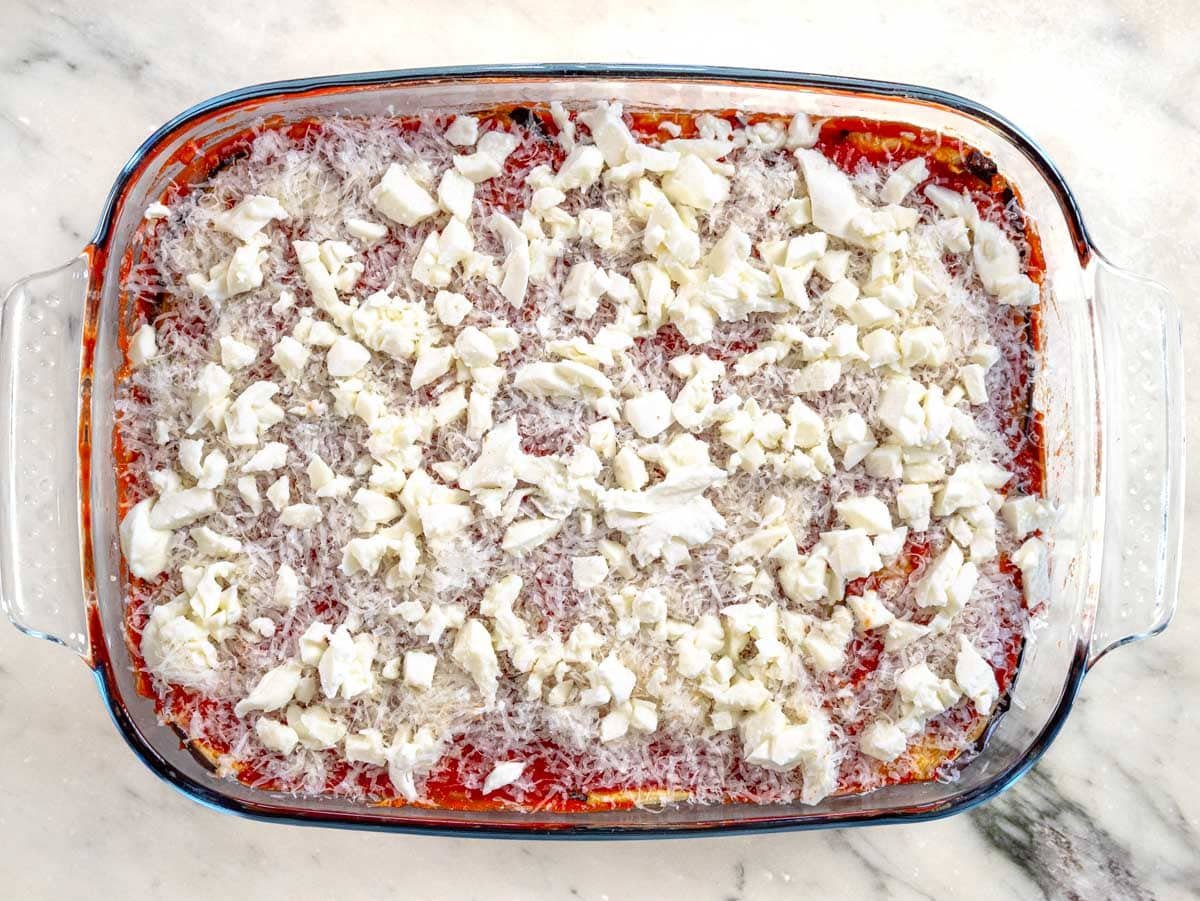
4. Bake the Parmigiana
Bake the eggplant parmigiana in a preheated oven at 350°F or 180°C for about 30 minutes until the tomato sauce bubbles and the cheese melts.
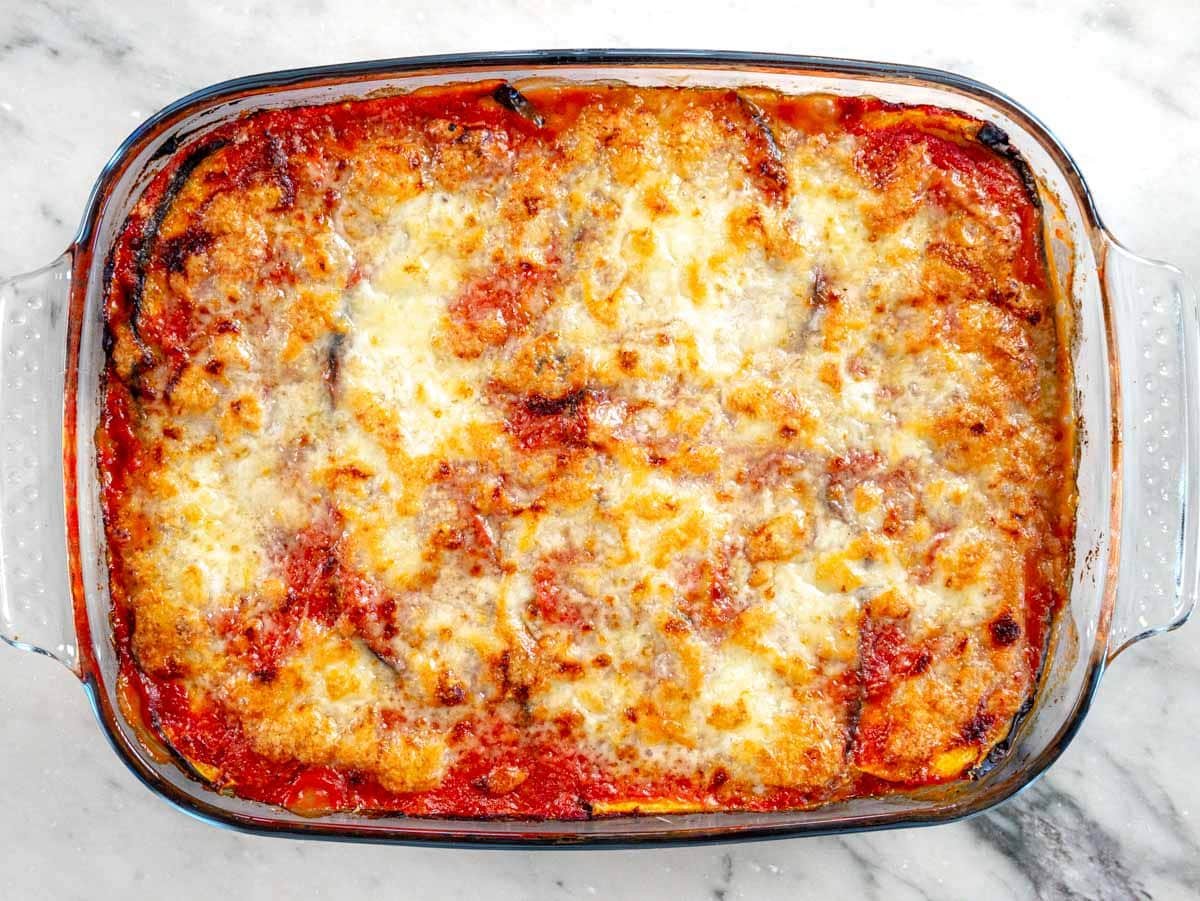
Let cool down for at least 15 minutes.
Cooling down is essential. The parmigiana will be easier to cut and taste much better if the ingredients have time to cool down and meld together.
Then garnish with fresh basil leaves and cut into six (main dish) or eight portions (side dish) with a sharp knife. Serve with a lasagna spatula.
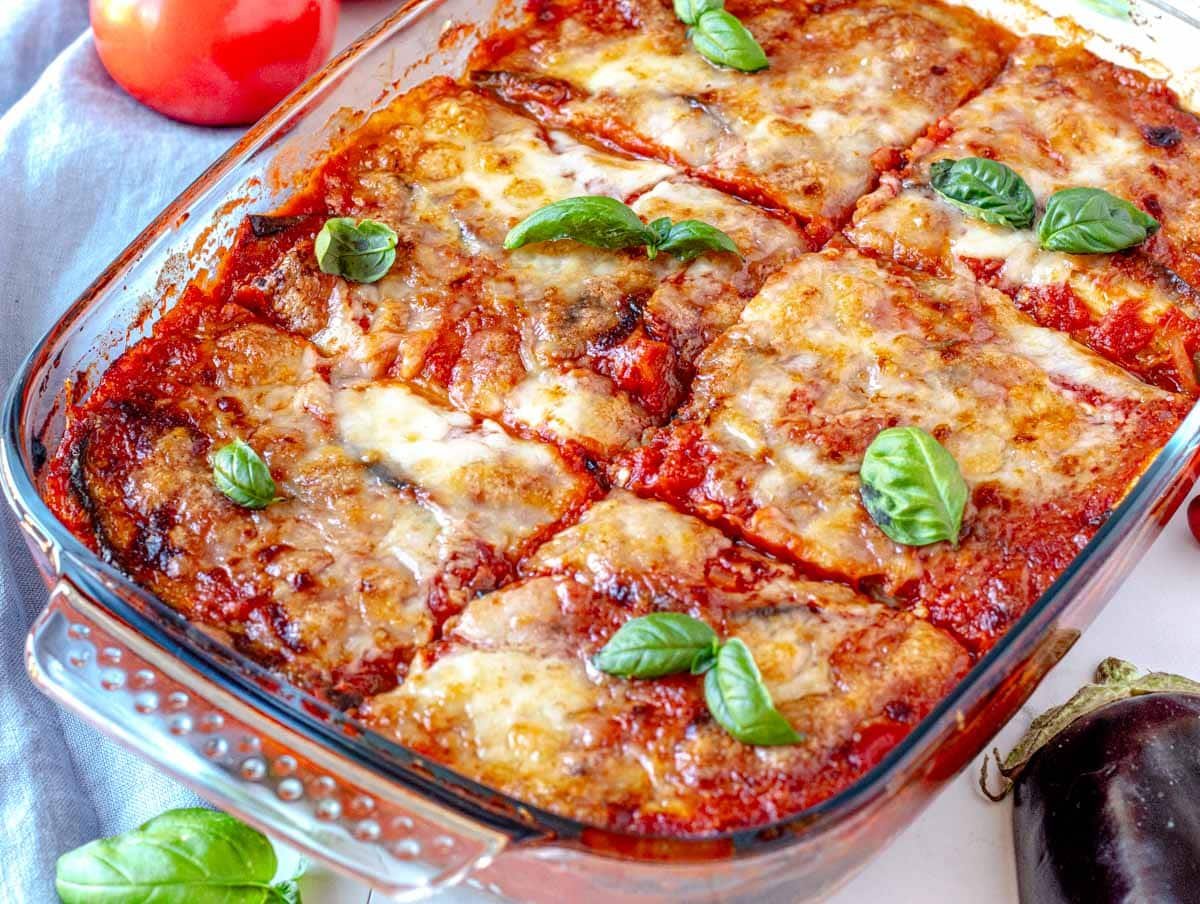
Serving Suggestions
Eggplant Parmigiana as an appetizer
In Italy, parmigiana is often served in small portions as an appetizer.
Put some good crusty bread or focaccia on the table so people can sop up the tomato sauce left over on their plates.
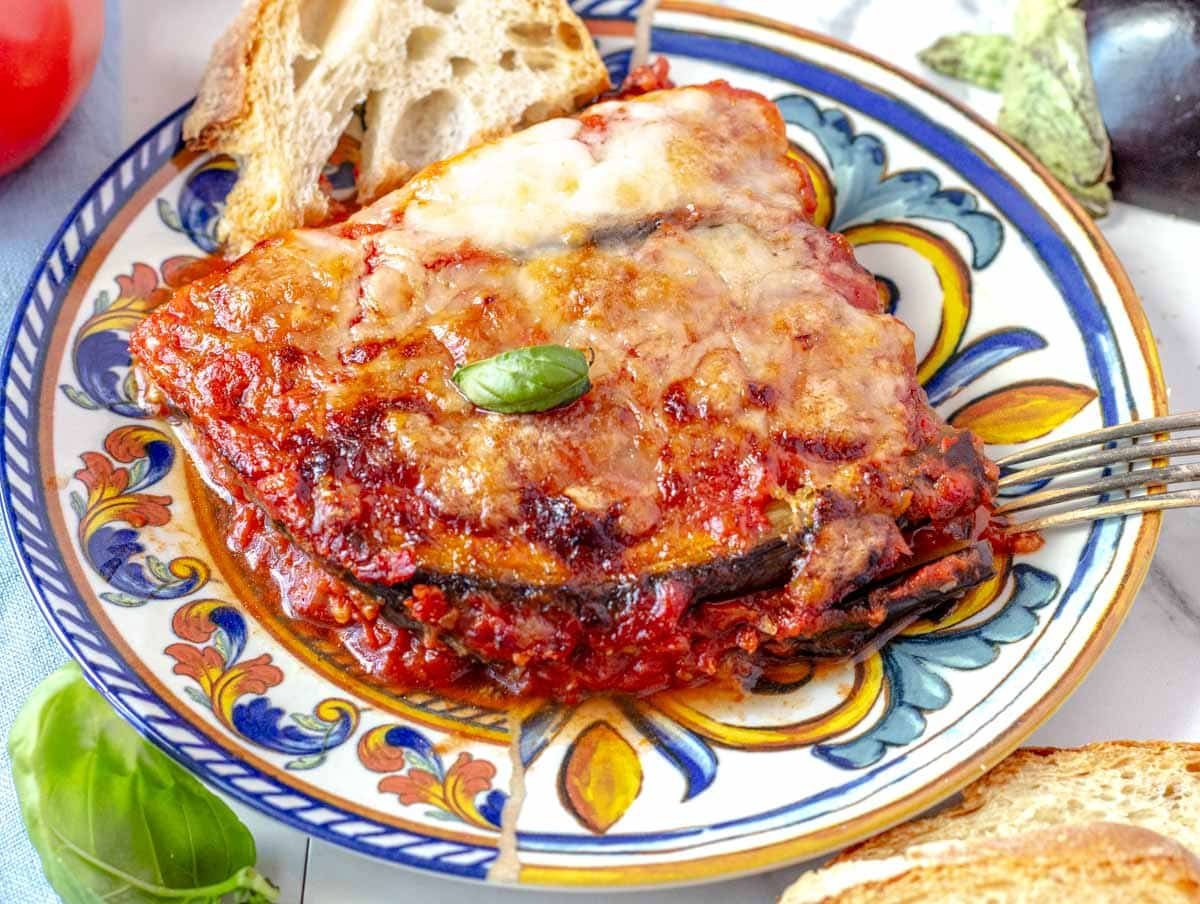
Eggplant Parmigiana as a main dish
Serve a larger portion as a main dish, with a fresh crunchy salad or an Italian salad and some crusty bread or focaccia on the side.
You can also serve it with other bread-based sides, such as crostini, bruschetta, and Panzanella.
Eggplant Parmigiana as a side dish
Cut the parmigiana into smaller portions to enjoy as a side dish. We recommend serving it with other vegetarian meals, such as:
Tips for making ahead
Parmigiana can be intimidating at first because of the different steps involved.
But the recipe is easier than you think.
You can break it down into smaller steps and make it at different stages.
For example, you can bake the eggplant slices and make the tomato sauce a day or two in advance.
Then assemble and bake the dish the day after, store it in the fridge, warm it up, and serve it on the third day.
It’s common practice in Italy to make parmigiana the day before serving it.
That’s because its flavors meld overnight in the fridge, and it tastes even better the day after.
It’s the perfect make-ahead meal because you can make it up to three days in advance.
Then, when you have guests over, you need to warm it up in the oven for 15 minutes.
What is essential, though, is that you bake the parmigiana as soon as you assemble it.
You cannot store it in the fridge before baking it. It will become watery and acidic, and it will not taste good.

Storage
Refrigerator: Let the eggplant parmigiana cool down completely at room temperature, then store it in the fridge in an airtight container or the same baking dish covered in plastic wrap for up to 3 days.
Reheat in the microwave for 2 minutes or in the oven at 350°F or 180°C for 15 minutes.
Freezer: You can also freeze Italian parmigiana. Let it cool completely at room temperature, then transfer it into a freezer-friendly container and freeze for up to 3 months.
Thaw & Reheat: Defrost it in the refrigerator overnight or microwave with the thawing function. Warm it in a preheated oven at 350°F or 180°C for 15 to 20 minutes.
Questions
Yes, you leave the skin on for eggplant parmesan and eggplant parmigiana.
The salt was used to remove bitterness and some water in the eggplant.
These days, you don’t have to salt eggplants because they are selectively bred, so they don’t grow bitter.
However, if you are deep-frying the eggplant and want drier, less juicy slices, you can salt them with coarse salt and let them sit for 1 hour to purge some of their juices.
Then rinse them and pat them dry with a paper towel. Don’t use fine salt because it penetrates the eggplant, making it too salty.
If you make eggplant parmesan with oven-baked eggplants, you don’t need to salt them because the water will evaporate while the slices cook in the oven.
Eggplant Parmigiana, also known as “Parmigiana di Melanzane” in Italian, is undoubtedly one of the most internationally known Italian dishes.
Its origins, though, are uncertain, and different Italian regions, including Sicily, Campania, and Emilia Romagna, claim to have invented this delicious dish.
The origin and meaning of the name are uncertain, and there are two primary schools of thought.
The first suggests that the dish’s name comes from Parmigiano Reggiano, a cheese produced in the Emilia Romagna region around Parma, Reggio Emilia, and Modena.
To further support this theory, there’s evidence that a few centuries ago, the name “cucina parmigiana” was used more broadly to refer to the local cuisine of the area around the city of Parma.
The second theory supports the idea that the name “parmigiana” comes from the Sicilian word “parmiciana,” which in English can be translated as “Italian wooden window shutter.”
Based on this theory, the way the eggplant slices are arranged in parmigiana recalls the shape of the wood slats of the window shutter, hence the name.
More Italian Recipes
If you’re also a fan of Italian cooking, check out these hearty Italian meals:
More Eggplant Recipes
If you love cooking with eggplant, try these favorite eggplant recipes:
For more eggplant inspiration, check out our 35 best eggplant recipes with pasta, salad, and appetizer ideas.
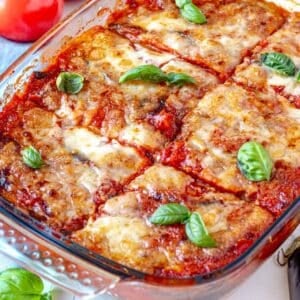
Eggplant Parmigiana
Equipment
- Baking dish or casserole 9 x 13 inches | 23 x 33 cm.
Ingredients
TOMATO SAUCE
- 2 tablespoons extra virgin olive oil
- 1 large onion finely chopped
- 3 cloves garlic pressed
- 5 cups tomato passata or tomato puree (the one in a glass bottle)
- ½ teaspoon salt
- ⅛ teaspoon black pepper
OVEN ROASTED EGGPLANT
- 4 pounds eggplants about 4 medium eggplants
- 3 tablespoons extra virgin olive oil
- ¾ teaspoon salt
OTHER INGREDIENTS
- 1½ cups (5 ounces) parmesan finely grated. We recommend Parmigiano Reggiano or Grana Padano. Substitute non-dairy parmesan.
- 2½ cups (10 ounces) mozzarella grated or chopped. Substitute non-dairy cheese.
- 1½ cups basil leaves fresh
Instructions
MAKE TOMATO SAUCE
- Heat 2 tablespoons extra virgin olive oil in a large skillet.Add 1 large onion (chopped) and sauté for 3 minutes, then add 3 cloves garlic (pressed) and sauté for one more minute.Pour in 5 cups tomato passata, and a splash of water, about ¼ cup, to rinse the tomato jar. Season with ½ teaspoon salt and ⅛ teaspoon black pepper.Simmer on medium low heat for 30 – 40 minutes, stirring occasionally. The sauce should be dense, not watery.In the meantime, bake the eggplants.
BAKE EGGPLANTS
- Preheat oven to 430°F or 220°C. Line three large baking trays with parchment paper.Rinse and dry 4 pounds eggplants, then cut off their stems.Slice the eggplants into 1/4-inch (0.6-cm) slices.Arrange on baking trays without overlapping.Brush with about 3 tablespoons extra virgin olive oil and season with ¾ teaspoon salt.Bake (fan-assisted if your oven has that) at 430°F or 220°C for about 25 minutes until golden brown. Tip: You might have to switch the trays in the oven – move the bottom tray to the top and so on – to ensure all eggplant slices are cooked properly.
ASSEMBLE PARMIGIANA
- BEFORE YOU START: Parmigiana has four layers, and the last layer has more sauce, parmesan, and mozzarella than the other layers.Keep this in mind when you add the sauce and the cheese.
- Cover the bottom of your casserole with a thin layer of tomato sauce. Add the first layer of eggplant slices, tight but without overlapping. Trim the slices with scissors if they are too large.Cover with a ladleful of tomato sauce and spread it with the back of a spoon.Drizzle with a couple of handfuls of grated parmesan cheese, a sprinkle of chopped or shredded mozzarella cheese, and a handful of basil leaves.Optionally, you can add a drizzle of extra virgin olive oil.
- Cover with the second layer of eggplant slices, this time arranged in the opposite direction.Add a ladleful of tomato sauce, a handful of grated parmesan, one of mozzarella, and some fresh basil leaves.Repeat with two more layers of eggplant slices (4 eggplant layers total).The last layer should have more tomato sauce, parmesan, and mozzarella than the other layers. Don’t add basil on top.
BAKE PARMIGIANA
- Bake in a preheated oven at 350°F or 180°C for about 30 minutes until the tomato sauce bubbles and the cheese melts.
- Let it cool down for at least 15 minutes. This is essential; don't skip it.Garnish with fresh basil leaves and cut into six (main dish) or eight portions (side dish) with a sharp knife. Serve with a lasagna spatula.
Notes
Nutrition
If you liked this eggplant parmigiana, you might also enjoy:
Collections
40 Italian Vegetarian Dishes
Collections
25 Easy Eggplant Recipes
Collections

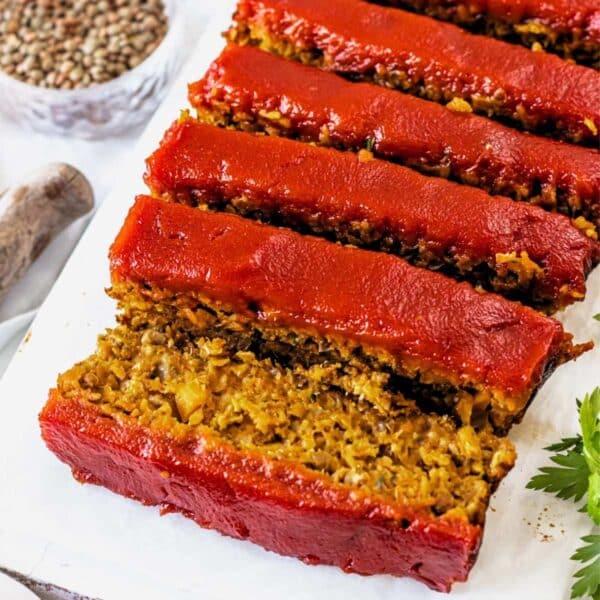
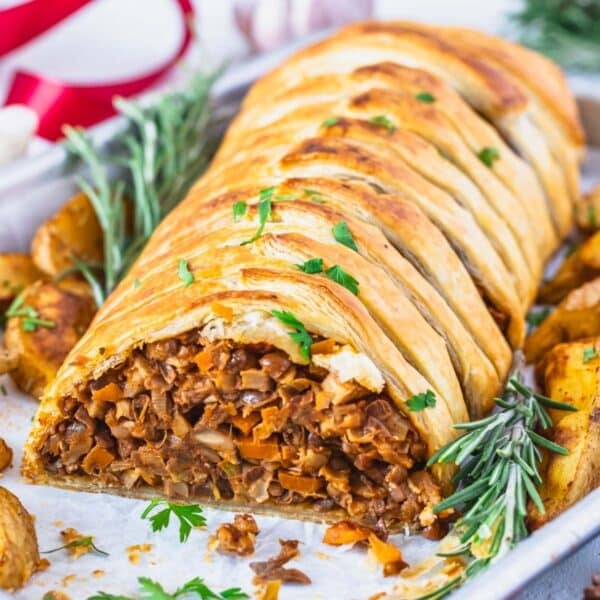
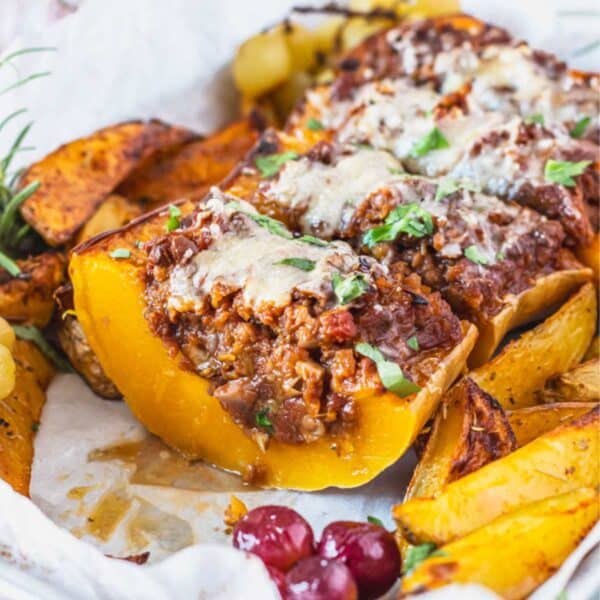
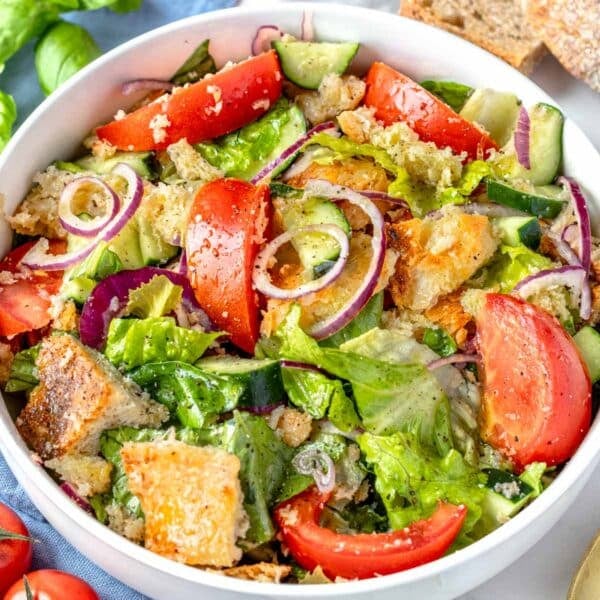
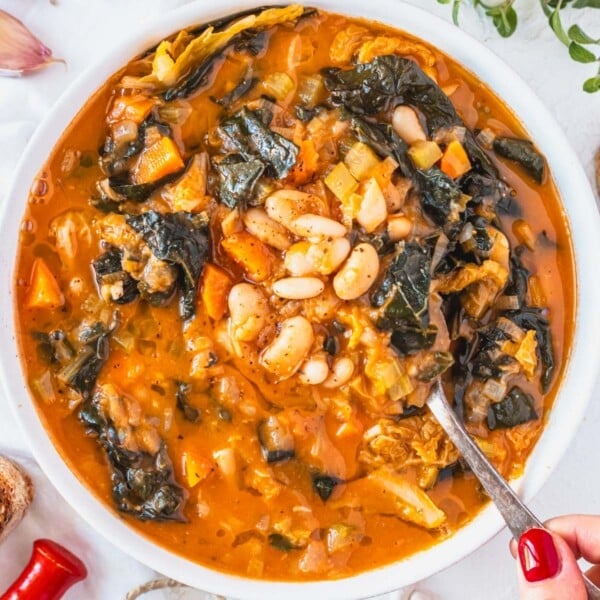
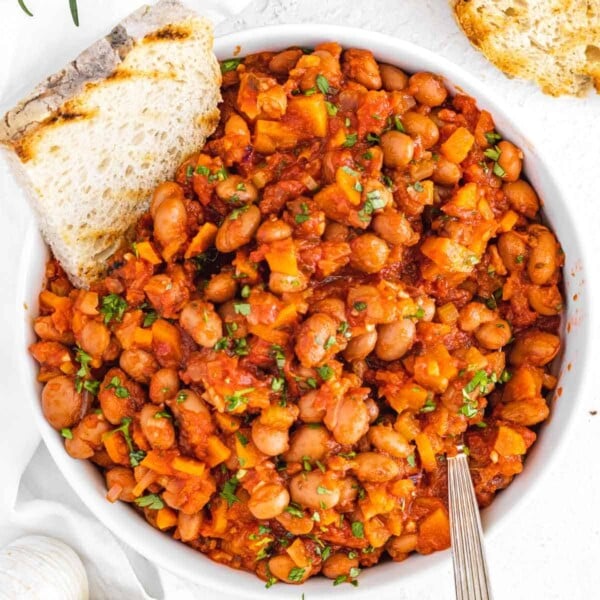
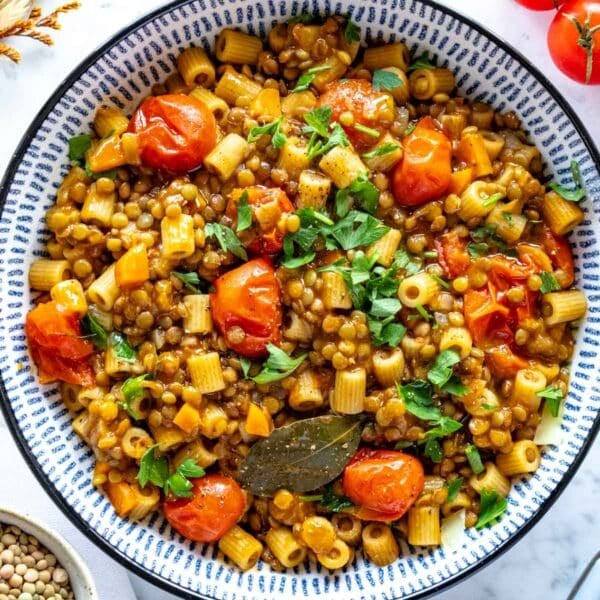
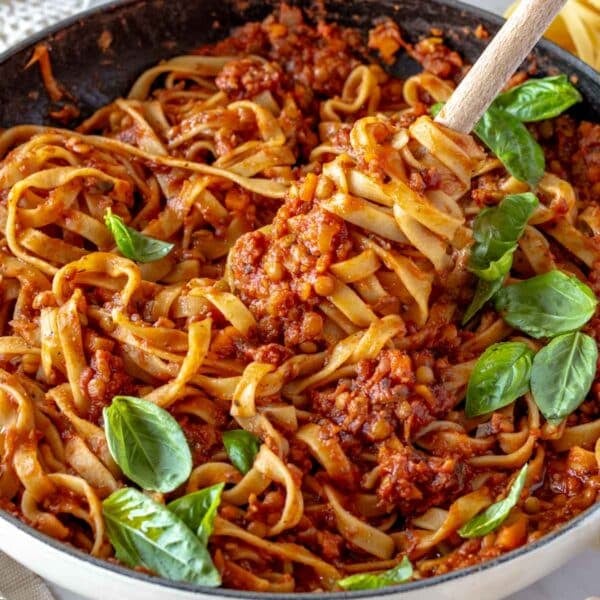

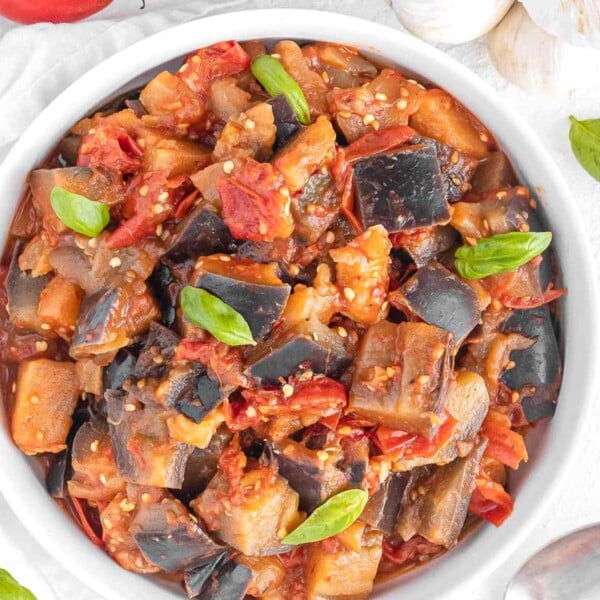
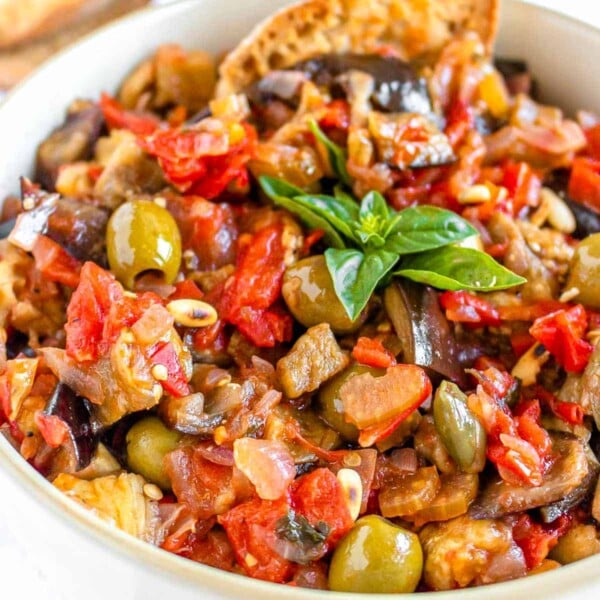
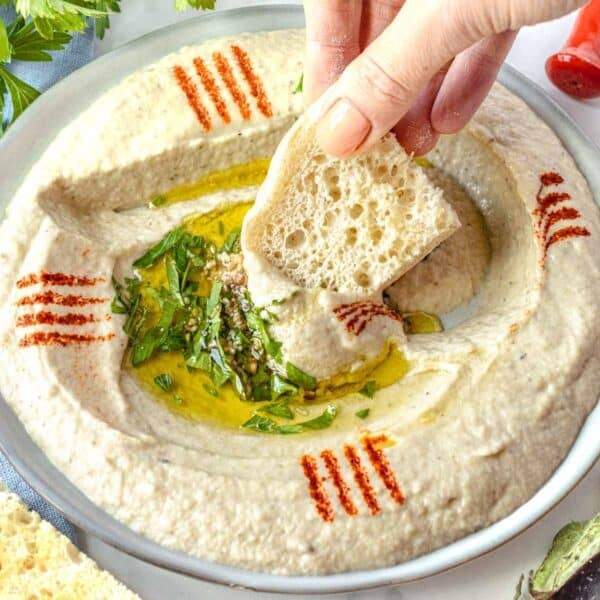
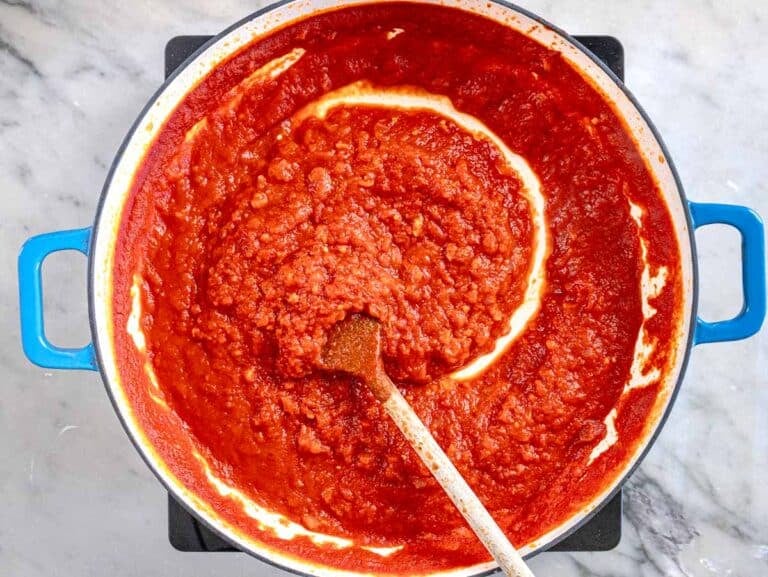
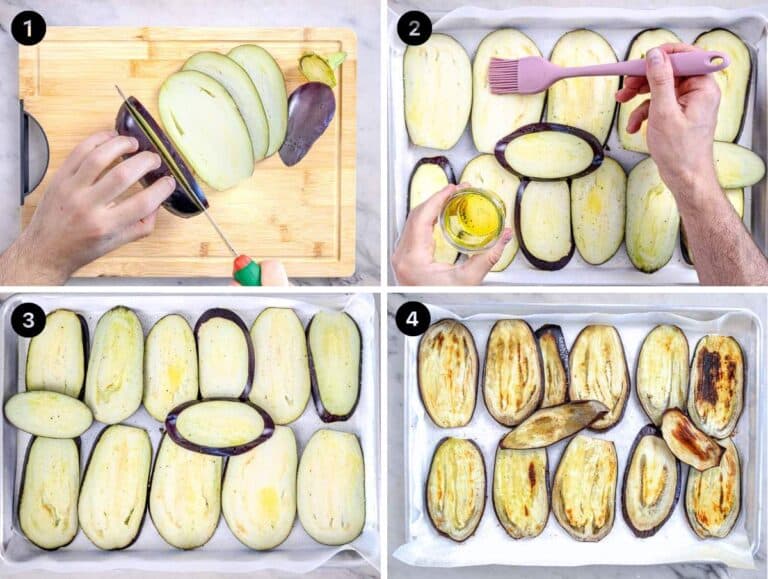
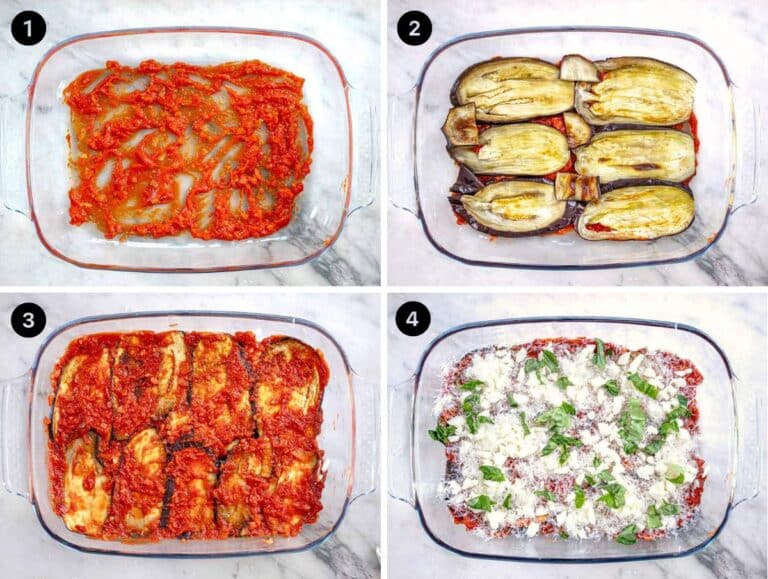

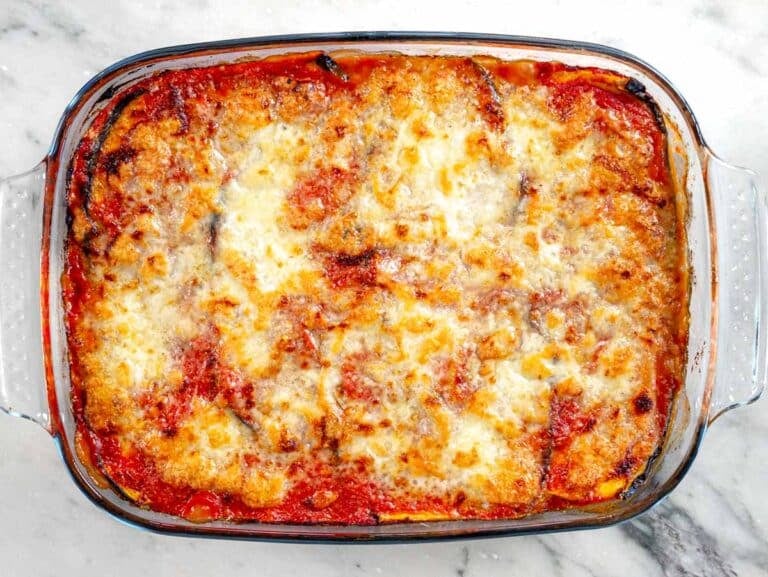
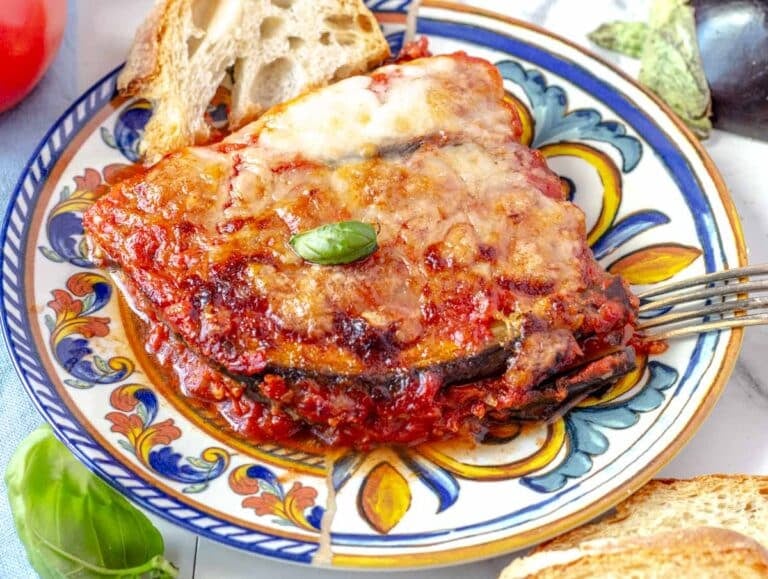

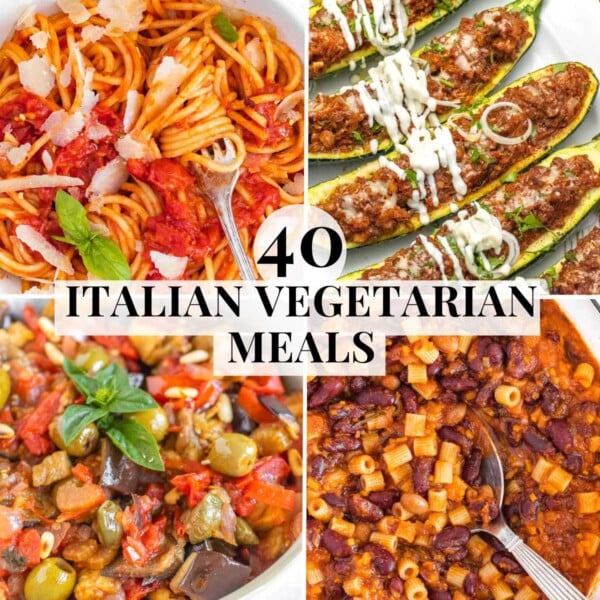
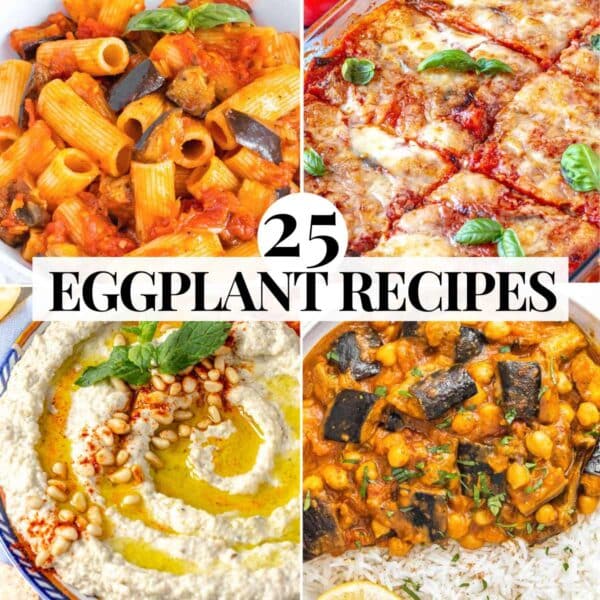
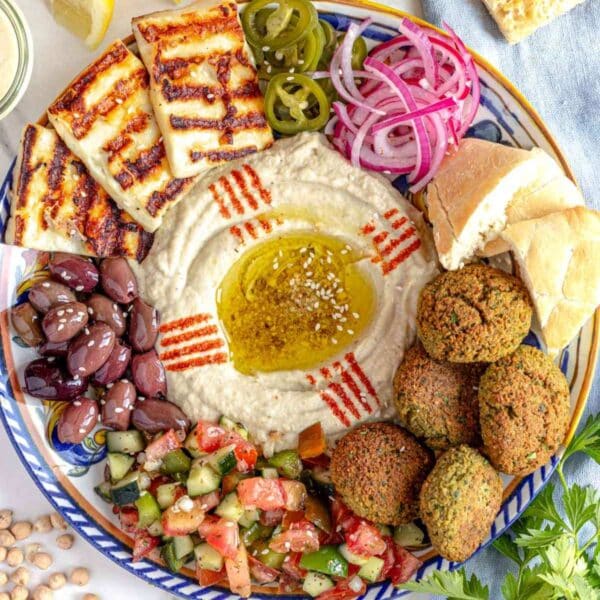

My guests loved this!
Fabulous, Ebe! I am so delighted to hear 🥰.
Thanks for another amazing recipe Chef. It came out perfect I just gave it my own color by:
1) Using smoky tempeh bacon instead of vegan Parmesan. I wanted to add a protein to make it a complete meal.
2) I cut the eggplant in discs and baked as per your directions. I then assembled the discs by putting them directly one on top of the other. This way it is pre-portioned and very easy/clean to serve individually.
Venuto buonissimo! Serviva solo la forchetta per tagliarlo 😁 Grazie!
Hola Chef,
Do you brush both sides of the eggplant with olive oil?
Thanks!
Sara
Ciao Sara! No need to oil both sides, only the side facing up from the baking tray 🙂
Happy cooking, and happy holidays! ☀️
O yea .. A recipe that doesn’t require frying !!! My Noni would probably not find this acceptable .. But for me .. THANK YOU !! This has always been my favorite but very time consuming .. Not to mention making a mess of the kitchen .. I’m going out to the store to buy ingredients .. This will be on my table tomorrow and definetly for Christmas ..
Thanks again !!!
Ciao Rita,
Yeah I’m with you, my Italian family-in-law always remark that the eggplant used to be fried (but they gladly take seconds of our version) 😂
Thank you for your feedback, I am so happy you feel like cooking after seeing this recipe. Happy holidays when you get there 🤗
Kindest, Louise
5 stars, OMG,
I made this eggplant Parmesan. It came out Extremely delicious. A lot of work, but it worth it. 100%
Love it!! Thank you💟
This is absolutely delicious . Never frying or breading again. I was cutting too thin in the beginning now I got it right . I added a basil cashew cream . And If I feel lazy I use raos .
Are you supposed to bake the eggplant before assembling and bake again???
thanks,
Marie
Hi Marie,
Yes, it’s a required step for a tasty and tender eggplant parmigiana to bake the eggplant slices before you assemble the parmigiana 🙂
I strongly recommend following the steps and pictures in the recipe box, the link is here: https://theplantbasedschool.com/vegan-eggplant-parmigiana/#wprm-recipe-container-2541
Hope that helps. Let me know if you have other questions.
Kindest, Louise
After having lived in Italy for a while 10 years ago, I’ve been trying to make this ever since but have always been put off by having to fry the aubergine slices and stinking the place out. This was easy, absolutely delicious and completely authentic. I did add sprinkles of olive oil between the layers and added a bit more of the cheeses on the top layer, all of which made it more oily than some people would like, but that’s exactly how I like my dinner.
Fantastic, Richard. I am happy that you jazzed up the parmigiana to your liking 🙂
Thank you for your kind review and for taking the time to leave a rating here. All the best,
Louise
I tried this and recipe and so wanted it to work for me but it was a bust. Seems like the eggplant are too thin. I barely got through the cooking time before they were burnt and more like eggplants chips. I’d prefer disks too- should those be thicker?
Hi Rula,
I am sorry the recipe didn’t work out for you.
You can cook the eggplant slices a little less and take them out of the oven before they burn (maybe our oven is not as hot as yours), or cut them slightly thicker (not much thicker though, you still want thin slices).
You can also cut disks if you prefer 🙂
I hope this helps and your next parmigiana will be a success!
All the best,
Nico